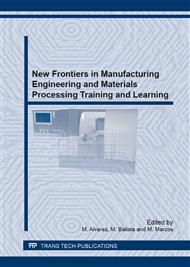[1]
G.-Romeu M.L., Ciurana, J., Albertí, M., Sabater, M., Planas, D., Terradas, M. (2005), "Sistema docente interactivo para el autoaprendizaje de elementos, partes y máquinas en procesos de fabricación", Proceedings MESIC 2005 I Manufacturing Engineering Society Internacional Conference, Calatayud, Spain, Vol. 1, p.75.
Google Scholar
[2]
Declaración de Bolonia. 1999.
Google Scholar
[3]
M.L. Pérez, J. Juando, II Jornadas Nacionales de Metodologías ECTS, Adaptación de la Universitat de Girona al espacio europeo de educación superior, Badajoz, 2007.
DOI: 10.61520/et.1782008.1053
Google Scholar
[4]
J. de Ciurana, Mª Luisa G.-Romeu Un model de gestió i material per a pràctiques en assignatures d'enginyeria de processos de fabricació 2009.
Google Scholar
[5]
ASCAMM centro tecnológico. http://www.ascamm.es/
Google Scholar
[6]
Altintas, Y. Manufacturing automation, metal cutting mechanincs, machine tool vibrations, and CNC design. USA: Cambridge University Press. 2000.
DOI: 10.1017/cbo9780511843723
Google Scholar
[7]
López de Lacalle, L. N., Sánchez, J. A., & Lamikiz, A. Mecanizado de alto rendimiento. procesos de arranque. (1ª ed.). Bilbao: Ediciones Técnicas Izaro, S.A. 2004.
Google Scholar
[8]
López de Lacalle, L.N., Lamikiz A, (Eds). Machine Tools for High Performance Machining. Springer. 2008.
Google Scholar
[9]
Groover MP, Society of Manufacturing Engineers. Fundamentals of modern manufacturing : materials, processes, and systems. 2nd ed. New York: John Wiley & Sons. 2004.
Google Scholar
[10]
Benardos PG, Vosniakos G-. Predicting surface roughness in machining: a review. International Journal of Machine Tools and Manufacture, 2003 6;43 (8):833-844.
DOI: 10.1016/s0890-6955(03)00059-2
Google Scholar
[11]
International Organization for Standardization. ISO-4287 Geometrical product specifications (GPS)—surface texture: profile method—terms, definitions and surface texture parameters. 1997.
DOI: 10.3403/30398213u
Google Scholar
[12]
International Organization for Standardization. ISO-4288 Geometrical product specifications (GPS): rules and procedures for the assessment of surface texture. 1996.
Google Scholar
[13]
Quintana, G., De Ciurana, J., and Ribatallada, J.,. Surface roughness generation and material removal rate in ball end milling operations. Materials and Manufacturing Processes, 25 (6), 386–398. 2010.
DOI: 10.1080/15394450902996601
Google Scholar
[14]
Quintana, G., Rudolf, T., Ciurana, J., Brecher, C Using kernel data in machine tools for the indirect evaluation of surface roughness in vertical milling operations. Robotics and Computer-Integrated Manufacturing 27 (6) , pp.1011-1018. 2011.
DOI: 10.1016/j.rcim.2011.05.005
Google Scholar
[15]
Quintana, G., Rudolf, T., Ciurana, J., Brecher, C .Surface roughness prediction through internal kernel information and external accelerometers using artificial neural networks. Journal of Mechanical Science and Technology 25 (11) , pp.2877-2886. 2011.
DOI: 10.1007/s12206-011-0806-0
Google Scholar


